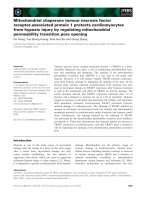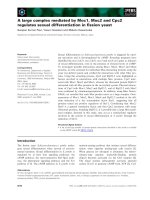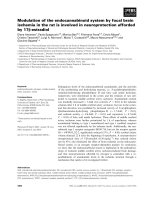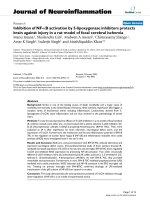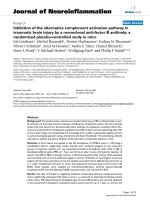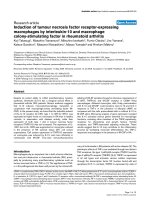Exercise preconditioning attenuates neurological injury by preserving old and newly formed HSP72-containing neurons in focal brain ischemia rats
Bạn đang xem bản rút gọn của tài liệu. Xem và tải ngay bản đầy đủ của tài liệu tại đây (2.08 MB, 11 trang )
Int. J. Med. Sci. 2019, Vol. 16
Ivyspring
International Publisher
675
International Journal of Medical Sciences
2019; 16(5): 675-685. doi: 10.7150/ijms.32962
Research Paper
Exercise Preconditioning Attenuates Neurological
Injury by Preserving Old and Newly Formed HSP72Containing Neurons in Focal Brain Ischemia Rats
Yu-Lin Wang1,2,3, Cheng-Hsien Lin4, Chi-Chun Chen5, Ching-Ping Chang6, Kao-Chang Lin7, Fong-Chin
Su1,8, Willy Chou3,9
1.
2.
3.
4.
5.
6.
7.
8.
9.
Department of Biomedical Engineering, National Cheng Kung University, Tainan, Taiwan
Center of General Education, Southern Taiwan University of Science and Technology, Tainan, Taiwan
Department of Physical Medicine and Rehabilitation, Chi-Mei Medical Center, Tainan, Taiwan
Department of Medicine, Mackay Medical College, New Taipei, Taiwan
Department of Electronic Engineering, National Chin-Yi University of Technology, Taichung, Taiwan
Department of Medical Research, Chi Mei Medical Center, Tainan, Taiwan
Department of Neurology, Chi Mei Medical Center, Tainan, Taiwan
Medical Device Innovation Center, National Cheng Kung University, Tainan, Taiwan
Department of Recreation and Healthcare Management, Chia Nan University of Pharmacy and Science, Tainan, Taiwan
Corresponding authors: Fong-Chin Su, PhD, Department of Biomedical Engineering, National Cheng Kung University, Tainan, Taiwan Mailing address:
No.1, University Road, Tainan City 701, Taiwan Phone: +886-6-2757575-63400 Fax: +886-6-2343270 E-mail: Willy Chou, MD, Department
of Physical Medicine and Rehabilitation, Chi-Mei Medical Center, Tainan, Taiwan Mailing address: No. 901, Zhonghua Rd., Yongkang District, Tainan City 710,
Taiwan Phone: +886-6-2812811 Fax: +886-6-2832639 E-mail:
© Ivyspring International Publisher. This is an open access article distributed under the terms of the Creative Commons Attribution (CC BY-NC) license
( See for full terms and conditions.
Received: 2019.01.09; Accepted: 2019.04.04; Published: 2019.05.10
Abstract
Background: Exercise preconditioning (EP+) is a useful and important procedure for the prevention of
stroke. We aimed to ascertain whether EP+ protects against ischemic brain injury by preserving heat
shock protein (HSP) 72-containing neurons in ischemic brain tissues.
Methods: Adult male Sprague-Dawley rats (n=240) were used to assess the contribution of
HSP72-containing neurons to the neuroprotective effects of EP+ on ischemic brain injury caused by
transient middle cerebral artery occlusion.
Results: Significant (P<0.05) increases in the percentages of both old HSP72-containing neurons
(NeuN+HSP72 double positive cells) (18~20% vs. 40~50%) and newly formed HSP72-containing neurons
(BrdU+NeuN+HSP72 triple positive cells); (2~3% vs. 16~20%) after 3 weeks of exercise coincided with
significant (P<0.05) reductions in brain ischemia volume (250 mm3 vs. 100 mm3), brain edema (78% vs.
74% brain water content), blood-brain barrier disruption (1.5 μg/g vs. 0.7 μg/g tissue Evans Blue dye
extravasation) and neurological motor deficits (neurological severity scores of 12 vs. 6 and maximal
angles of 60° vs. 20°) in brain ischemia rats. Reductions in the percentages of both old (from 40~50% to
10~12%) and newly formed (from 18~20% to 5~7%) HSP72-containing neurons by gene silencing with an
intracerebral injection of pSUPER small interfering RNA showed a significant (P<0.05) reversal in the
neuroprotective outcomes. Our data provide an inverse correlation between the EP+-mediated increases
in both old and newly formed HSP72-containing neurons and the extent of cerebral ischemic injury.
Conclusions: The percentages of both old and newly formed HSP72-containing neurons are inversely
correlated with the outcomes of ischemic brain injury. Additionally, preischemic treadmill exercise
improves the outcomes of ischemic brain injury by preserving both the old and newly formed
HSP72-containing neurons in rats.
Key words: Exercise, heat shock protein 72, neuroprotection, ischemic brain injury
Introduction
The American Heart Association/American
Stroke Association has promoted that the primary
prevention of stroke is particularly important [1].
Exercise preconditioning (EP+) is widely believed to
Int. J. Med. Sci. 2019, Vol. 16
be a safe and effective preventive measure for people
who undergo a stroke [2]. Clinical data have also
shown that physical inactivity before stroke predicts a
higher risk of being dependent both before and after
stroke [3, 4]. Although preischemic EP+ can attenuate
neurobehavioral deficits after ischemic brain injury
[5], the exact neuroprotective mechanisms of
preischemic EP+ against cerebral ischemic injury
remain unclear.
In the normal rat brain, there is little to no
expression of inducible heat shock protein (HSP) 72
[6]. However, following occlusion of the middle
cerebral artery, HSP72 induction in the ischemic core,
or penumbra, occurs primarily in neurons, but HSP72
can also be expressed in astrocytes, microglia and
endothelial cells [6, 7]. On the other hand, EP+
increases neuronal and astroglial levels of HSP72 in
the gray matter of spinal cord tissue in normal rats [8].
Transfection and viral overexpression of HSP72 in
neurons and glia protects against in vitro ischemia [6]
and in vivo ischemia [8, 9]. Additionally, knocking
out HSP72 worsens the outcomes and transgenic
overexpression improves the outcomes of cerebral
ischemia [10]. Pharmacological induction of HSP72
protects against cerebral ischemia [11]. Although it is
well known that EP+ reduces neuronal apoptosis in
stroke rats by upregulating HSP72 in the brain [12], it
is unknown whether EP+ increases neuronal
expression of HSP72 in normal rat brain tissues and
protects against ischemic brain injury in rats by
preserving old and newly formed HSP72-containing
neurons.
In the present study, we first used
immunofluorescence staining methods to elucidate
whether old and/or newly formed HSP72-containing
neurons can be upregulated by preischemic EP+ in
rats with or without middle cerebral artery occlusion
(MCAO). Second, we describe the contributions of old
and/or newly formed HSP72-containing neurons to
EP+-mediated attenuation of neurological injury
(including brain infarct, neurological motor deficits,
blood-brain barrier (BBB) disruption, and brain
edema) in a ischemic brain injury model in rats [13].
To inhibit HSP72 expression in the brain tissue, the
ischemic brains were intraoperatively microinjected
with pSUPER plasmid expressing HSP72 small
interfering RNA (siRNA-HSP72) [12, 14].
Materials and methods
Animals and stroke model
Two hundred forty adult male Sprague-Dawley
rats (weight, 248±15 g) were housed under controlled
environmental conditions
with an ambient
temperature of 24±2°C, a relative humidity of 65%
676
and a 12-h light/dark cycle, with free access to food
and water. Three weeks after treadmill EP+, ischemic
brain injury was induced by MCAO in rats by
intraluminal filaments, using the relatively
noninvasive technique detailed previously [15]. The
protocol was approved by the Institutional Review
Board for Animal Care and Use (Assurance Number:
100120755).
Recombinant pSUPER plasmid expressing
siRNA-HSP72 constructed using the pSUPER vector
(Oligo Engine, Seattle, WA, USA), which contains the
polymerase-III H1-RNA gene promoter and can direct
the synthesis of siRNA-like transcripts. The target
sequence for HSP72 (Gen Bank Accession No.
NM-0319712) was chemically synthesized (Tri-1
Biotech, Taipei, Taiwan) as complementary
oligonucleotides. The synthetic oligonucleotides of
siRNA-HSP72 5’-GATCCCCGGAGATCATCGCCAA
CGACTAAGAGAGTTGGCGATGATCTCCTTTTTG
GAAA-3’ and 3’-GGGCCTCTAGTAGCGGTTGCTG
AAGTTCTCTCAGCAACCGCTACTAGAGGAAAA
ACCTTTTCGAA-5’ were annealed and cloned
downstream of the H1 promoter to construct a
recombinant pSUPER HSP72 plasmid. The cloned
HSP72 target sequence was sequence-confirmed using
a DNA sequencer (ABI Prism 377, Applied
Biosystems, Foster City, CA, USA). During the MCAO
surgery, an acute dose of siRNA-HSP72 (12.5 μg/rat
in 25 μl of pSUPER RNAi delivery media
[siRNA-vector]) was microinjected into the frontal
cortex at a flow rate of 0.5 μl/min using a
microinfusion pump (CMA 100, Carnegie Medicine
AB, Stockholm, Sweden) according to the coordinates
of the atlas of Paxinos and Watson [16]. A single
28-gauge stainless steel injection cannula was lowered
into the right frontal cortex (coordinates: 12 mm
anterior to bregma, 4.6 mm lateral to midline and 3.0
mm ventral to the skull surface).
Exercise preconditioning (EP+) protocol
Animals were trained on a treadmill (model
Exer-3/6, Columbus Instruments, Columbus, OH,
USA) 5 days a week for 3 weeks. They were
acclimatized to run for 15 min at 20 m/min at 0° for 3
days initially, and then they were running for 30 min
at 20 m/min, 30 min at 30 m/min and 60 min at 30
m/min after 1, 2 and 3 weeks of training, respectively.
Nonexercise preconditioning controls (EP-) were
placed daily on a stationary treadmill and were given
electrical stimulation in a manner identical to that
used for the EP+ group.
Exercise groups and procedures
The animals were randomly assigned to one of
eight groups: (i) EP-+MCAO- rats that received an
Int. J. Med. Sci. 2019, Vol. 16
intracerebral injection of siRNA-vector (EP-+
MCAO-+siRNA-vector), (ii) EP-+MCAO-+siRNAHSP72, (iii) EP++MCAO-+siRNA-vector, (iv) EP++
MCAO-+siRNA-HSP72, (v) EP-+MCAO++siRNAvector, (vi) EP-+MCAO++siRNA-HSP72, (vii) EP++
MCAO++siRNA-vector, and (viii) EP++MCAO++
siRNA-HSP72. The experimental procedures in this
study are shown in Figure 1. Of all the rats in this
study, 13 rats were excluded because of death prior to
sacrifice, including 0 in the EP-+MCAO-+
siRNA-vector group (i); 0 in the EP-+MCAO-+
siRNA-HSP72 group (ii); 0 in the EP++MCAO-+
siRNA-vector group (iii); 0 in the EP++MCAO-+
siRNA-HSP72 group (iv); 4 in the EP-+MCAO++
siRNA-vector group (v); 4 in the EP-+MCAO++
siRNA-HSP72 group (vi); 2 in the EP++MCAO++
siRNA-vector group (vii); 3 in the EP++MCAO++
siRNA-HSP72 group (viii).
In experiment 1, the percentages of cortical and
striatal old HSP72-containing neurons (i.e.,
HSP72+NeuN+DAPI-positive cells) were determined
3 days after the MCAO or sham operation in all
groups (Figure 2).
In experiment 2, the percentages of newly
formed
neurons
containing
HSP72
(i.e.,
HSP72+NeuN+BrdU+DAPI-positive cells) in cortical
and striatal tissue of the ipsilateral brain were
determined 3 days after MCAO or sham operation in
all groups (Figure 3). We examined the same regions
of the right frontal cortex and the striatum in both the
ischemic brains and nonischemic brains.
In experiment 3, the neurobehavioral functions
were determined 1 day before the injury and 3 days
after injury in all groups (Figure 4).
In experiment 4, the cerebral infarct volumes
were determined 3 days after the MCAO or sham
operation in all groups (Figure 5).
In experiment 5, the BBB permeability and Evans
Blue dye extravasation were determined 3 days after
the MCAO or sham operation in all groups (Figure 6).
Neurobehavioral function test
Acute neurological motor deficits were assessed
in all groups the day before and 3 days after MCAO or
sham injury using both a neurological severity score
test [17] and an inclined system with a microcontroller
[18]. The former reveals a composite of the motor,
sensory, and reflex test scores, whereas the latter
measures limb strength. The modified Neurological
Severity Score (mNSS), which comprises tests of
motor, sensory, beam balance, reflex absence and
abnormal movement functions, was used to evaluate
the neurological function of the rats before and after
the operation. Neurological function was graded on a
scale of 0-18: 1-6, mild injury; 7-12, moderate injury;
677
13-18, severe injury. The inclined plane was used to
measure limb strength. The inclined plane used in this
study was constructed of a 60 cm × 60 cm adjustable
acrylic panel. A motor and a ball screw were used to
control the inclined angle of the acrylic plane from 0°
(horizontal) to 70° [18]. The angle was increased or
decreased in 5° increments to determine the maximal
angle at which an animal could maintain balance on
the plane. The data for each day were the mean values
of the left- and right-side limb maximal angles.
Assessment of cerebral infarct
The rats were deeply anesthetized, and brains
were rapidly removed, frozen in liquid nitrogen and
then sectioned for immunohistochemistry. Brain
sections were stained with 2,3,5-triphenyl-tetrazolium
chloride (TTC) as detailed previously [19]. The infarct
volume (mm3) was measured in each slice and
summed using computerized planimetry [20]. We
also adopted the method of Lin et al. [21] to correct the
distortion of infarct volume caused by brain edema.
Bromodeoxyuridine labeling
Bromodeoxyuridine (BrdU), a thymidine analog
that is incorporated into the DNA of dividing cells
during the S-phase, was used for mitotic labeling
(Roche Diagnostics, Indianapolis, IN, USA; 50 mg/kg)
as described previously [22]. BrdU was administered
intraperitoneally immediately at the beginning of
surgery and once daily for 3 consecutive days. Three
days after MCAO, brains were removed for BrdU
labeling. The BrdU immunostaining procedure with a
specific antibody against BrdU (1:400; Roche
Diagnostics)
and
the
quantification
of
BrdU-immunoreactive
cells
were
described
previously [22].
Immunofluorescence staining
Three days after MCAO, rat brains were
prepared as described above. The brains were
embedded in paraffin and serially sectioned (10 μm)
from the frontal cortex to the commencement of the
hippocampus by a research assistant who was blinded
to the study protocol. Every 10th section was then
collected for immunofluorescence staining. For each
animal, 6 serial coronal sections with 100-μm intervals
were collected from the cortex. Sections were
incubated in 2 mol/L HCl for 30 min, rinsed in 0.1
mol/L boric acid (pH 8.5) for 3 min at room
temperature, and then incubated with primary
antibodies in phosphate-buffered saline (PBS)
containing 0.5% normal bovine serum at 4°C
overnight; secondary antibodies were incubated for 1
h at room temperature. The sections were cover
slipped with mounting medium (Fluorescent
Mounting Medium; Dako). The labeled cells were
Int. J. Med. Sci. 2019, Vol. 16
678
calculated in 5 coronal sections from each rat and are
expressed as the mean number of cells per section. For
negative control sections, all the procedures were
performed without the primary antibody. The
primary and secondary antibodies for multiple
staining are listed in Table 1.
spectrophotometer at 610 nm and quantified
according to a standard curve. The results are
presented as μg of Evans Blue dye per g of tissue.
Statistical analysis
GraphPad Prism (version 7.01 for Windows;
GraphPad Software, San Diego, CA, USA) was used
for all statistical analyses. Data are expressed as the
means±standard deviation (SD). Statistical analysis
was performed using two-way analysis of variance
(ANOVA) with Tukey’s and Bonferroni post hoc
testing to analyze the percentage of infarct area and
the behavioral performance, respectively. Histological
measures were analyzed using one-way ANOVA
with Bonferroni post hoc tests. A value of P<0.05 was
considered statistically significant.
Brain water content and Evans blue dye
extravasation assays
The water content of the ipsilateral brains was
evaluated via the wet weight/dry weight ratio
method, as previously reported [23]. Evans blue dye
extravasation assays were performed in accordance
with the methods of Lin et al. [24]. Three hours before
sacrifice, animals received an intravenous dose of
Evans Blue dye (4%, 0.25 ml/rat). The quantity of
extravasated Evans Blue dye was detected by a
Table 1. Immunofluorescent staining in a focal ischemic injury rat model.
Antibody
Primary Antibody
NeuN
HSP72
DAPI
BrdU
Secondary Antibody (conjugation)
Mouse IgG (Alexa Fluor 568)
Rabbit IgG (Alexa Fluor 488)
Antigen
Host
Company
Catalog#
Dilution
Neuron
HSP72
Nucleic acid
Bromodeoxyuridine
Mouse
Rabbit
Rat
Millipore
Abgent
Invitrogen
Abcam
MAB377
ASM10001
D1306
Ab6326
1:400
1:200
1:20000
1:200
Mouse IgG
Rabbit IgG
Goat
Goat
Invitrogen
Invitrogen
A11031
A11034
1:200
1:200
Figure 1. Experimental procedure outline. Treadmill exercise preconditioning (EP+) was performed in Sprague-Dawley rats 3 weeks before middle cerebral artery
occlusion (MCAO). The filament was removed after 60 min of MCAO to allow reperfusion. At the onset of reperfusion, separated groups of rats were given
intracortical injections of 12.5 µg of siRNA-HSP72 or siRNA-vector. Three days after MCAO, neurological function tests, brain water content, Evans blue dye
extravasation, and immunohistological examinations were performed.
Int. J. Med. Sci. 2019, Vol. 16
679
Figure 2. Immunofluorescence detection of heat shock protein (HSP)-72-containing (NeuN+HSP72+DAPI-positive) neurons in the frontal cortex (A) and striatum
(B) 3 days after middle cerebral artery (MCAO). For group abbreviations, see the Methods section. Upper panels: the immunofluorescence images are representative
of results from different groups of animals. Lower panels: values represent the mean ± SD of ten rats per group. *P<0.05, EP++MCAO-+siRNA-vector vs.
+P<0.05,
&P<0.05,
EP-+MCAO-+siRNA-vector;
EP++MCAO-+siRNA-HSP72
vs.
EP++MCAO-+siRNA-vector;
EP-+MCAO++siRNA-vector
vs.
EP-+MCAO-+siRNA-vector; §P<0.05, EP++MCAO++siRNA-vector vs. EP-+MCAO++siRNA-vector; and #P<0.05, EP++MCAO++siRNA-HSP72 vs.
EP++MCAO++siRNA-vector. Arrows denote HSP72-containing neurons.
Results
Cerebral percentages of old HSP72-containing
neurons were higher in EP+ rats
As shown in Figure 2, the percentages of old
HSP72-containing neurons (i.e., NeuN+HSP72positive cells) in ipsilateral brain regions, including
the frontal cortex and the striatum (Figure 1a, b), were
~20% in the EP-+MCAO-+siRNA-vector rats and 10%
in the EP-+MCAO++siRNA-vector rats. EP+
significantly increased the percentage of old
HSP72-containing neurons to 40-50% for the
EP++MCAO++siRNA-vector rats and 30-35% for the
EP++MCAO-+siRNA-vector rats (Figure 2). The
increased percentage of old HSP72-containing
neurons in the ipsilateral brains following EP+ was
significantly reduced by intracerebral injection of
pSUPER siRNA-HSP72 (down to 20-25%). Compared
rats, the
to
the
EP-+MCAO++siRNA-vector
+
EP +MCAO++siRNA-vector rats had a significantly
higher percentage of old HSP72-containing neurons
Int. J. Med. Sci. 2019, Vol. 16
(~35% vs. 10%). However, the EP++MCAO++
siRNA-HSP72 rats had a significantly lower
percentage of old HSP72-containing neurons (5%)
than did the EP++MCAO++siRNA-vector rats.
Figure 3 shows that the percentages of newly
formed HSP72-containing neurons (i.e., BrdU+
NeuN+HSP72-positive cells) in ipsilateral brain
regions, including the frontal cortex and the striatum,
in both the EP-+MCAO-+siRNA-vector and
EP-+MCAO-+siRNA-HSP72 rats were within 2-3%.
EP+ significantly increased the percentage of newly
formed HSP72-containing neurons to 13-15%, as
shown in the EP++MCAO-+siRNA-vector rats (Figure
3). Additionally, the EP+-induced, newly formed
HSP72-containing neurons in the ipsilateral frontal
680
cortex and striatum were significantly reduced by an
intracerebral injection of pSUPER siRNA-HSP72
(down to 4-5%), as shown in the EP++MCAO-+
siRNA-HSP72 rats (Figure 3). Compared to the
EP-+MCAO++siRNA-vector rats, the EP++MCAO++
siRNA-vector rats had a significantly higher
percentage of newly formed HSP72-containing
neurons (16-20% vs. 4-5%) (Figure 3). Additionally,
the increased percentages of newly formed
HSP72-containing neurons in both the ipsilateral
frontal cortex and striatum were significantly
reversed by pSUPER siRNA-HSP72 but not by
pSUPER siRNA-vector (~18% vs. ~4%) (Figure 2) in
the MCAO+ rats.
Figure 3. Immunofluorescence detection of newly formed HSP72-containing neurons (BrdU+NeuN+HSP72+DAPI-positive cells) in the frontal cortex (A) and
striatum (B) 3 days after MCAO. For group abbreviations, see the Methods section. Upper panels: the immunofluorescence images are representative of results from
different groups of animals. Lower panels: values represent the mean ± SD of ten rats per group. *P<0.05, EP++MCAO-+siRNA-vector vs.
+P<0.05,
§P<0.05,
EP-+MCAO-+siRNA-vector;
EP++MCAO-+siRNA-HSP72
vs.
EP++MCAO-+siRNA-vector;
EP++MCAO++siRNA-vector
vs.
EP-+MCAO++siRNA-vector; and #P<0.05, EP++MCAO++siRNA-HSP72 vs. EP++MCAO++siRNA-vector. Arrows denote newly formed HSP72-containing neurons.
Int. J. Med. Sci. 2019, Vol. 16
681
Figure 4. Effects of exercise on cerebral infarct volume in different groups of rats 3 days post-MCAO. Please see the Methods section for group abbreviations. Upper
panels: the infarct volume (mm3), as revealed by negative 2,3,5-triphenyl tetrazolium chloride staining, indicating dehydrogenase-deficient tissue (pale area), was
measured in each slice and summed using computerized planimetry for different groups of rats. Lower panels: values represent the mean ± SD of eight to ten rats per
group.*P<0.01, EP-+MCAO++siRNA-vector vs. EP-+MCAO-+siRNA-vector; +P<0.05, EP++MCAO++siRNA-vector vs. EP-+MCAO++siRNA-vector; and #P<0.05,
EP++MCAO++siRNA-HSP72 vs. EP++MCAO++siRNA-vector.
Neurological motor deficits after MCAO were
lower in EP+ rats
All EP-+MCAO-+siRNA-vector, EP-+MCAO-+
and
siRNA-HSP72,
EP++MCAO-+siRNA-vector
+
EP +MCAO +siRNA-HSP72 rats displayed normal
neurological motor function as evidenced by “0”
mNSS and 60° maximal angles (Figure 4). Both the
and
EP-+MCAO++
EP-+MCAO++siRNA-vector
siRNA-HSP72 groups of rats had significantly
(P<0.01) higher neurological severity scores (12.5±2.1
vs. 2.0±0.2) and lower maximal angles (18±1° vs.
60±3°) than did the EP- control rats. However, the
EP++MCAO++siRNA-vector rats had significantly
(P<0.05) lower neurological severity scores (6.2±0.4 vs.
12.5±2.1) and higher maximal angles (18±2° vs.
6.2±0.4°) than did the EP+ control rats. Additionally,
the beneficial effects of EP+ in promoting neurological
motor recovery following MCAO were significantly
(P<0.05) reversed by siRNA-HSP72 as shown in the
EP++MCAO++siRNA-HSP72 rats (P<0.05) (Figure 4).
Cerebral infarction and edema after MCAO
were attenuated in EP+ rats
All EP-+MCAO-+siRNA-vector, EP-+MCAO-+
and
siRNA-HSP72,
EP++MCAO-+siRNA-vector
Int. J. Med. Sci. 2019, Vol. 16
EP++MCAO-+siRNA-HSP72
rats
displayed
insignificant differences among the groups regarding
cerebral infarction (Figure 5), Evans Blue dye
extravasation and water content (Figure 6). Both the
and
EP-+MCAO++
EP-+MCAO++siRNA-vector
siRNA-HSP72 groups had significantly (P<0.01)
greater infarct volume (250±12 mm3 vs. 0 mm3),
increased Evans Blue dye extravasation (1.42±0.07
μg/g vs. 0.25±0.06 μg/g) and higher water content
(78.5±1.1% vs. 73.2±0.8%) than did the EP- control rats.
However, the EP++MCAO++siRNA-vector rats had
682
significantly (P<0.05) lower brain infarction (125±11
mm3), decreased Evans Blue dye extravasation
(0.68±0.04 μg/g), and lower brain water content
(74.6±10%) than did the EP-+MCAO++siRNA-vector
rats. However, the beneficial effects of EP+ in
attenuating brain infarction, Evans Blue dye
extravasation and brain water content following
MCAO were significantly (P<0.05) reversed by
siRNA-HSP72 (Figure 5 and Figure 6) (brain infarct
volume, 247±12 mm3; Evans Blue dye extravasation,
0.68±0.04 μg/g; and brain water content, 78.9±1.0%).
Figure 5. Effects of exercise on both neurological severity scores (A) and maximal angles (B) in different groups of rats 3 days post-MCAO. Data represent the mean
± SD (n=8-10 per group). *P<0.01, EP-+MCAO++siRNA-vector vs. EP-+MCAO-+siRNA-vector or EP-+MCAO++siRNA-HSP72 vs. EP-+MCAO-+siRNA-vector;
+P<0.05, EP++MCAO++siRNA-vector vs. EP-+MCAO++siRNA-vector; and #P<0.05, EP++MCAO++siRNA-HSP72 vs. EP++MCAO++siRNA-vector.
Int. J. Med. Sci. 2019, Vol. 16
683
Figure 6. Effects of exercise on both blood-brain barrier (BBB) permeability (i.e., Evans Blue dye extravasation) and brain edema (i.e., brain water content) in
different groups of rats 3 days post-MCAO. Data represent the mean ± SD (n=5-6 per group). *P<0.01, EP-+MCAO++siRNA-vector vs. EP-+MCAO-+siRNA-vector;
+P<0.05, EP++MCAO++siRNA-vector vs. EP-+MCAO++siRNA-vector; #P<0.05, EP++MCAO++siRNA-HSP72 vs. EP++MCAO++siRNA-vector.
Discussion
The most striking findings of the present study
are that EP+ provides significant neuroprotection
against ischemic brain injury by preserving both old
HSP72-containing neurons and newly formed
HSP72-containing neurons. Our present results are
consistent with many previous findings. For example,
both in vitro cerebral ischemic injury and in vivo
spinal cord ischemic injury can be ameliorated by
transfection and viral overexpression of HSP72 in
neurons and glia. Mice and rats overexpressing
HSP72 are protected against cerebral infarction
[25-27]. Knockout of HSP72 worsens ischemic brain
injury in rodents with focal brain ischemia [28].
Geldanamycin induces HSP72 in the brain and
protects against focal ischemic brain injury in rats [29,
30].
Previous studies have demonstrated that EP+
induced a 70% higher expression of HSP72 in the
ischemic brain and diminished neuronal injury in rats
with MCAO [6]. Antibody inhibition of EP+-induced
mild HSP72 expression in the ischemic brain
completely blocked EP+-induced neuroprotection.
This result indicates that the increased HSP72 levels
prior to ischemia and reperfusion brain injury may be
one of the key issues. In the present study, in
sham-operated rats (i.e., MCAO- rats), EP+ increased
the percentage of both old HSP72-containing neurons
(from 19% to 45%) and newly formed
HSP72-containing neurons (from 2.5% to 16%) (Figure
3a, 3b). Intracerebral injection of pSUPER
siRNA-HSP72 significantly reduced the percentage of
both old and newly formed HSP72-containing
neurons to 25% and 10%, respectively. At the same
time, MCAO+ significantly attenuated the percentage
of old and newly formed HSP72-containing neurons
to 10% and 5%, respectively. The reduction of
HSP72-containing neurons in MCAO rats was
blocked by EP+ (30% and 18%, respectively, for old
and newly formed HSP72-containing neurons). The
beneficial effects of EP+ in preserving the old
HSP72-containing neurons and increasing the newly
formed HSP72-containing neurons in ipsilateral brain
tissues were attenuated by intracerebral injection of
siRNA-HSP72 to 15% and 4.5%, respectively. These
results suggest that HSP72 antibody or siRNA-HSP72
gene silencing had an effect by neutralizing HSP72 or
reducing the accumulation of HSP72-containing
neurons produced by EP+ in the brain, leading to
interference of an anti-neural injury mechanism.
EP+ provides significant protection against acute
cerebral ischemic injury (present results and [31]). EP+
induces brain ischemic tolerance through the
promotion
of
angiogenesis,
mediation
of
inflammatory responses, and inhibition of neuronal
apoptosis. EP+-mediated overexpression of cerebral
HSP72 improves outcomes of severe ischemic injury
via increasing brain derived neurotrophic factor
(BDNF)
production
and/or
decreasing
neuroinflammation and neuronal apoptosis (via
elevated Bcl-2/Bax ratio, preventing formation of the
apoptosome, and inhibition of caspase-3) [12, 32-34].
Cerebral overexpression of HSP72 exerts both
anti-inflammatory and antiapoptotic effects and
facilitates neuroprotection. In mice with comparable
cerebral ischemic injury, overexpression of HSP72
reduced the density of glial fibrillary acidic protein
(GFAP)-positive cells and decreased astrocyte
morphological complexity [35]. In addition,
HSP72-mediated EP+ may attenuate BBB disruption
and cerebral ischemic injury in rats via inhibiting the
Int. J. Med. Sci. 2019, Vol. 16
684
matrix metalloproteinase-9 (MMP-9) [36]/nuclear
factor
NF-κB
[6]
pathway.
Furthermore,
HSP72-mediated preconditioning exercise might
reduce cerebral ischemic injury and neuronal
apoptosis through endogenous 14-3-3γ [31].
Competing Interests
Conclusion
1.
In conclusion, a significant (P<0.05) increase in
the percentages of both old and newly formed
HSP72-containing neurons after 3 weeks of exercise
coincided with a significant (P<0.05) reduction in
brain infarct volume, brain edema, BBB disruption,
and neurological motor deficits in cerebral ischemic
injury rats. Reductions in the percentages of both the
old and newly formed HSP72-containing neurons by
pSUPER siRNA showed a significant (P<0.05) reversal
in the neuroprotective effects of EP+. Our data provide
an inverse correlation between the EP+-mediated
upregulation
of
old
and
newly
formed
HSP72-containing neurons and the extent of cerebral
ischemic injury. Our data demonstrate that
preischemic treadmill exercise improves cerebral
ischemic injury by preserving the percentages of both
old HSP72-containing neurons and newly formed
HSP72-containing neurons.
Abbreviations
EP+: exercise preconditioning; HSP72: heat shock
protein 72; siRNA: small interfering RNA; BrdU:
bromodeoxyuridine;
NeuN:
neuronal
nuclei;
pSUPER: suppression of endogenous RNA; MCAO:
middle cerebral artery occlusion; TTC: 2,3,5-triphenyltetrazolium chloride; PBS: phosphate-buffered saline;
DAPI: 4’,6-diamidino-2-phenylindole.
Acknowledgments
This study is partially supported by the Ministry
of Science and Technology (Taiwan) under grant no.
MOST 107-2314-B-384-007-MY3, grant no. MOST
108-2314-B-715-001, and the Chi Mei Medical Center,
Tainan, Taiwan under grant no. CMFHT10401.
Author contributions
Study design: Fong-Chin Su, Willy Chou
Performed the experiments & data collection:
Yu-Ling Wang, Cheng-Hsien Lin, Chi-Chun Chen
Statistical
analysis:
Ching-Ping
Chang,
Kao-Chang Lin
Data interpretation: Yu-Ling Wang, Willy Chou
Manuscript preparation: Fong-Chin Su, Willy
Chou
Literature search: Yu-Ling Wang, Ching-Ping
Chang, Kao-Chang Lin
The authors have declared that no competing
interest exists.
References
2.
3.
4.
5.
6.
7.
8.
9.
10.
11.
12.
13.
14.
15.
16.
17.
18.
19.
20.
21.
22.
23.
24.
25.
26.
Goldstein LB, Bushnell CD, Adams RJ, et al. Guidelines for the primary
prevention of stroke: a guideline for healthcare professionals from the
American Heart Association/American Stroke Association. Stroke. 2011; 42:
517-84.
Wolf PA, Clagett GP, Easton JD, et al. Preventing ischemic stroke in patients
with prior stroke and transient ischemic attack : a statement for healthcare
professionals from the Stroke Council of the American Heart Association.
Stroke. 1999; 30: 1991-4.
Reinholdsson M, Palstam A, Sunnerhagen KS. Prestroke physical activity
could influence acute stroke severity (part of PAPSIGOT). Neurology. 2018; 91:
e1461-e67.
Rist PM, Capistrant BD, Mayeda ER, et al. Physical activity, but not body mass
index, predicts less disability before and after stroke. Neurology. 2017; 88:
1718-26.
Zhao JH, Meng XL, Zhang J, et al. Oxygen glucose deprivation
post-conditioning protects cortical neurons against oxygen-glucose
deprivation injury: role of HSP70 and inhibition of apoptosis. J Huazhong
Univ Sci Technolog Med Sci. 2014; 34: 18-22.
Sharp FR, Zhan X, Liu D-Z. Heat shock proteins in the brain: role of Hsp70,
Hsp 27, and HO-1 (Hsp32) and their therapeutic potential. Translational stroke
research. 2013; 4: 685-92.
Sharp FR, Lu A, Tang Y, et al. Multiple molecular penumbras after focal
cerebral ischemia. J Cereb Blood Flow Metab. 2000; 20: 1011-32.
Chang CK, Chou W, Lin HJ, et al. Exercise preconditioning protects against
spinal cord injury in rats by upregulating neuronal and astroglial heat shock
protein 72. Int J Mol Sci. 2014; 15: 19018-36.
Zhan X, Ander BP, Liao IH, et al. Recombinant Fv-Hsp70 protein mediates
neuroprotection after focal cerebral ischemia in rats. Stroke. 2010; 41: 538-43.
Giffard RG, Han R-Q, Emery JF, et al. Regulation of apoptotic and
inflammatory cell signaling in cerebral ischemia: the complex roles of heat
shock protein 70. Anesthesiology. 2008; 109: 339-48.
Mohanan A, Deshpande S, Jamadarkhana PG, et al. Delayed intervention in
experimental stroke with TRC051384--a small molecule HSP70 inducer.
Neuropharmacology. 2011; 60: 991-9.
Chio CC, Lin HJ, Tian YF, et al. Exercise attenuates neurological deficits by
stimulating a critical HSP70/NF-kappaB/IL-6/synapsin I axis in traumatic
brain injury rats. J Neuroinflammation. 2017; 14: 90.
Lin CM, Chang CK, Chang CP, et al. Protecting against ischaemic stroke in rats
by heat shock protein 20-mediated exercise. Eur J Clin Invest. 2015; 45:
1297-305.
Brummelkamp TR, Bernards R, Agami R. A system for stable expression of
short interfering RNAs in mammalian cells. Science. 2002; 296: 550-3.
Hoehn BD, Palmer TD, Steinberg GK. Neurogenesis in rats after focal cerebral
ischemia is enhanced by indomethacin. Stroke. 2005; 36: 2718-24.
Paxinos G, Watson C. The rat brain in stereotaxic coordinates. 7th ed. New
York Elsevier Academic Press. 2013;
Chen SF, Hsu CW, Huang WH, et al. Post-injury baicalein improves
histological and functional outcomes and reduces inflammatory cytokines
after experimental traumatic brain injury. Br J Pharmacol. 2008; 155: 1279-96.
Chang MW, Young MS, Lin MT. An inclined plane system with
microcontroller to determine limb motor function of laboratory animals. J
Neurosci Methods. 2008; 168: 186-94.
Bederson JB, Pitts LH, Germano SM, et al. Evaluation of
2,3,5-triphenyltetrazolium chloride as a stain for detection and quantification
of experimental cerebral infarction in rats. Stroke. 1986; 17: 1304-8.
Gartshore G, Patterson J, Macrae IM. Influence of ischemia and reperfusion on
the course of brain tissue swelling and blood-brain barrier permeability in a
rodent model of transient focal cerebral ischemia. Exp Neurol. 1997; 147:
353-60.
Lin TN, He YY, Wu G, et al. Effect of brain edema on infarct volume in a focal
cerebral ischemia model in rats. Stroke. 1993; 24: 117-21.
Zhang RL, Zhang ZG, Zhang L, et al. Proliferation and differentiation of
progenitor cells in the cortex and the subventricular zone in the adult rat after
focal cerebral ischemia. Neuroscience. 2001; 105: 33-41.
Huang B, Krafft PR, Ma Q, et al. Fibroblast growth factors preserve
blood-brain barrier integrity through RhoA inhibition after intracerebral
hemorrhage in mice. Neurobiol Dis. 2012; 46: 204-14.
Lin HJ, Hsu CC, Chio CC, et al. Gamma-Secretase Inhibitors Attenuate
Neurotrauma and Neurogenic Acute Lung Injury in Rats by Rescuing the
Accumulation of Hypertrophic Microglia. Cell Physiol Biochem. 2017; 44:
1726-40.
van der Weerd L, Lythgoe MF, Badin RA, et al. Neuroprotective effects of
HSP70 overexpression after cerebral ischaemia--an MRI study. Exp Neurol.
2005; 195: 257-66.
Rajdev S, Hara K, Kokubo Y, et al. Mice overexpressing rat heat shock protein
70 are protected against cerebral infarction. Ann Neurol. 2000; 47: 782-91.
Int. J. Med. Sci. 2019, Vol. 16
685
27. Hoehn B, Ringer TM, Xu L, et al. Overexpression of HSP72 after induction of
experimental stroke protects neurons from ischemic damage. J Cereb Blood
Flow Metab. 2001; 21: 1303-9.
28. Lee SH, Kwon HM, Kim YJ, et al. Effects of hsp70.1 gene knockout on the
mitochondrial apoptotic pathway after focal cerebral ischemia. Stroke. 2004;
35: 2195-9.
29. Kwon HM, Kim Y, Yang SI, et al. Geldanamycin protects rat brain through
overexpression of HSP70 and reducing brain edema after cerebral focal
ischemia. Neurol Res. 2008; 30: 740-5.
30. Lu A, Ran R, Parmentier-Batteur S, et al. Geldanamycin induces heat shock
proteins in brain and protects against focal cerebral ischemia. J Neurochem.
2002; 81: 355-64.
31. Otsuka S, Sakakima H, Terashi T, et al. Preconditioning exercise reduces brain
damage and neuronal apoptosis through enhanced endogenous 14-3-3gamma
after focal brain ischemia in rats. Brain Struct Funct. 2018;
/>32. Otsuka S, Sakakima H, Sumizono M, et al. The neuroprotective effects of
preconditioning exercise on brain damage and neurotrophic factors after focal
brain ischemia in rats. Behav Brain Res. 2016; 303: 9-18.
33. Hayes K, Sprague S, Guo M, et al. Forced, not voluntary, exercise effectively
induces neuroprotection in stroke. Acta Neuropathol. 2008; 115: 289-96.
34. Koo JH, Kwon IS, Kang EB, et al. Neuroprotective effects of treadmill exercise
on BDNF and PI3-K/Akt signaling pathway in the cortex of transgenic mice
model of Alzheimer's disease. Journal of exercise nutrition & biochemistry.
2013; 17: 151-60.
35. Barreto GE, White RE, Xu L, et al. Effects of heat shock protein 72 (Hsp72) on
evolution of astrocyte activation following stroke in the mouse. Exp Neurol.
2012; 238: 284-96.
36. Chaudhry K, Rogers R, Guo M, et al. Matrix metalloproteinase-9 (MMP-9)
expression and extracellular signal-regulated kinase 1 and 2 (ERK1/2)
activation in exercise-reduced neuronal apoptosis after stroke. Neurosci Lett.
2010; 474: 109-14.
